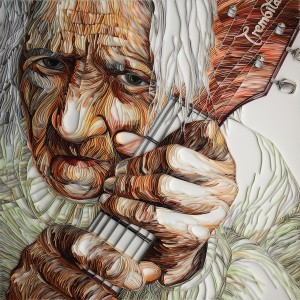Amazing Paper Artworks: The Art of Yulia Brodskaya
GALO: Do you prefer doing commercial work or your own personal projects?
YB: Both are important. I’d like to keep the right balance, but at the moment commercial work dominates quite significantly. I’m fine with this for the moment. I’m sure there will be more time for personal work in future. But now I need to take the opportunities that come my way.
GALO: In 2010, you also made a cover for Elizabeth Gilbert’s book Committed – the sequel to the bestseller Eat, Pray, Love. Who approached you for this project and what were your reasons for accepting this commission? Were you a fan of the preceding book?
YB: I must admit, I haven’t read the book. I’ve seen [the] first half of the movie though… I’ve been approached by the book publishers in the UK. Later the same design had been requested from some other countries as well. Usually I take on commissions when I find the brief interesting or unusual and all the other aspects are right (e.g. deadline/budget/work complexity); the Committed cover commission was just right in all those important aspects.
GALO: How long did this assignment take you?
YB: A couple of weeks overall (from sketches to shooting).
GALO: Did you read Committed after taking on the project?
YB: I don’t have time to read books. I can only listen to audio books. I do that quite a lot while I’m working, but I haven’t checked if Committed is available as an audiobook already. I wouldn’t mind listening to it.
GALO: Which project has been your favorite thus far?
YB: I don’t like playing favorites with my works. As a general rule, I enjoy the projects that allow me to have the most creative freedom, and there is not too much time pressure – this way I really enjoy working on them and I believe that they are more successful in the end.
GALO: On average, how much money does a typical commissioned piece bring in?
YB: It depends on the project. The price range is significant from editorial commissions that are usually the cheapest to full scale advertising campaigns that can bring much more money. It also depends on the brand.
GALO: What part of your creative process do you find to be the most difficult?
YB: When a client doesn’t like something that I really like and I have to make the changes despite the fact that I don’t agree with them. In some of the cases I can convince the clients to trust my judgment, but this doesn’t happen very often.
GALO: What kind of paper do you usually use for your projects? And how many sheets?
YB: I don’t count the sheets. I use all sorts of paper, predominantly heavy ones that are flexible enough and do not crease.
GALO: A lot of your artwork is construed at your kitchen table. Why do you like this space?
YB: Not any longer…I’ve moved to a new place, although I still work on exactly the same table. It now stands in my small studio space and no more eating is happening on it [smiles].
GALO: I read that one artist who inspires you is Gustav Klimt, the Austrian Symbolist painter. What specifically fascinates you about this artist? Is there anyone else who you admire?
YB: No one comes close to him in terms of my inspiration. I don’t know why I like his work that much. I admire all the details and ornaments that form a big picture making the works so intricate and fascinating. I hate explaining why I love something…My verbal skills are not that good to really explain ‘why.’
(Article continued on next page)

